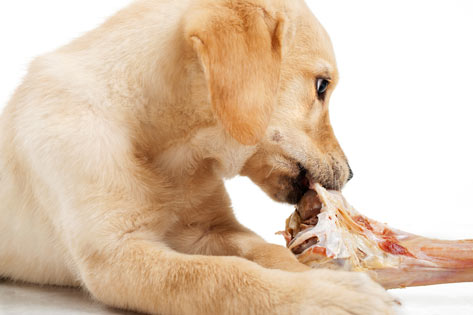Article from Clinician's Brief
Unconventional Diets
Marjorie L. Chandler, DVM, MS MANZCVSc, DACVN,
DACVIM, DECVIM-CA, MRCVS
University of Edinburgh

The expert says...
Clients may choose to feed unconventional diets (eg, home-prepared, raw, vegetarian) for multiple reasons, including having negative feelings about commercial pet foods and positive ideas about alternative diets. Negative beliefs include concerns or misconceptions about ingredients (eg, fillers, by-products, road kill, and carbohydrates) and toxicities. Other clients may prefer to fee so-called "natural" (eg, what a wild canid or felid would eat, not containing synthetic ingredients) or raw foods, to prepare food for their pet, or to avoid triggering a real or suspected food intolerance or allergy.
INGREDIENTS IN COMMERCIAL FOODS
Pet foods offer contain by-products (ie, secondary products) from human-food processing. These include offal (ie, organ meats) and parts that are nutritious but may by unappealing to humans, at time dependent on cultural or religious beliefs. For example, stomach or intestines may be included in pet food, and although these may be considered undesirable in some cultures, they are regularly consumed by humans in others. These products are often nutritious and result in good use of the carcass. Commercial diets may also contain antioxidant preservatives to prevent nutrient degradation and fat rancidification. Some contain coloring to make food more visually appealing to clients; this coloring is the same as that added to processed human food and is generally considered safe.
There is misconception that fillers, such as sawdust or other indigestible or nutrient-poor products are included in commercial pet foods. However, pet foods do contain fiber (ie, indigestible ingredients), which serves many functions (eg, as probiotics for bacteria, to promote colonocyte health). Otherwise, ingredients in commercial diets typical have nutritional function.
The concept that road kill or dead pets are included in U.S. commercial diets is unfounded. On the other hand, toxin (eg, melamine) that can be found in pet foods resulted in a recall of many pet products in 2007. This incident exemplifies adulteration of a food product with a previously unknown toxin and as such would have been nearly impossible to predict. The industry took action during the recall, and the FDA has improved reporting of suspected contaminate food ingredients in response.
PERCEIVED BENEFITS OF NATURAL OR VEGETARIAN DIETS
Feeding dogs a diet similar to that of wild dogs or wolves (ie, low in grains or carbohydrates) has a popular following. Some clients opt to feed bones and raw foods, thought to be similar to a wolf eating a carcass or a cat catching prey. Clients should be reminded that dogs have been domesticated over the past 10,000 to 15,000 years, during which time their diet involved greater consumption of grains. Their genetic makeup evolved to accommodate this increase in dietary carbohydrates, and today dogs are genetically dissimilar to wolves in several key genes that involve starch digestion and glucose uptake. Many other metabolic traits were unaffected by domestication, and dogs as well as cats select a rather low-carbohydrate diet by choice, although both species can digest carbohydrates. Cats are obligate carnivores, requiring higher protein (generally meat, fish or poultry) levels than do dogs.
TIPPING THE BALANCE: HOMEMADE FEEDING PROGRAMS
Essential Nutrient Needs
Clients should understand that homemade and raw-food feeding programs are meant to balance pets’ diets over weeks, rather than after an individual meal. This can be achieved with correct ingredients, but almost no homemade diet recipes (when tested) were found to be balanced, whether fed via a single diet or several rotating diets, for all essential nutrients. One nutritional study for the bones and raw-food (BARF) diet showed it to be deficient in calcium, phosphorus, potassium, and zinc and excessively high in vitamin D. Varying foods would unlikely balance the deficiencies in homemade diets; recipes, regardless of ingredients, were deficient in the same nutrients.
Some adult pets can cope with some imbalances for months to years before clinical signs become apparent, but these imbalances may have serious effects on growing animals, even if the diet is fed for only a short time.
Global Resources
To ensure essential nutrient needs are met, all diet nutrient profiles (analyzed or computer calculated) should be checked against nutrient requirements, such as those published by the Association for American Feed Control Officials (aafco.org), the National Research Council Canada (nrc-cnrc.gc.ca/eng), or the European Pet Food Industry Federation (rediaf.org/self-regulation/nutrition). Clients can also be directed to the WSAVA Global Nutrition Toolkit (wsava.org/nutrition-toolkit).
